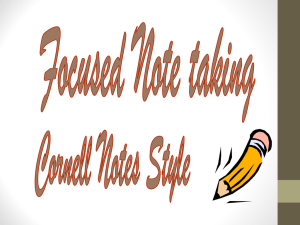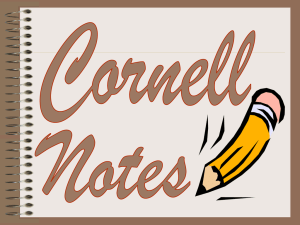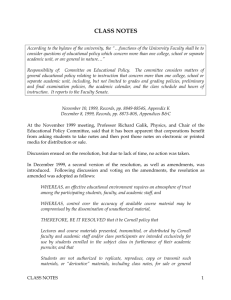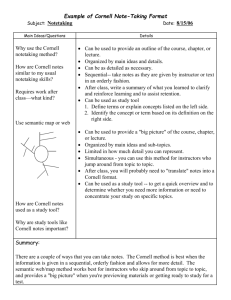ppt version
advertisement
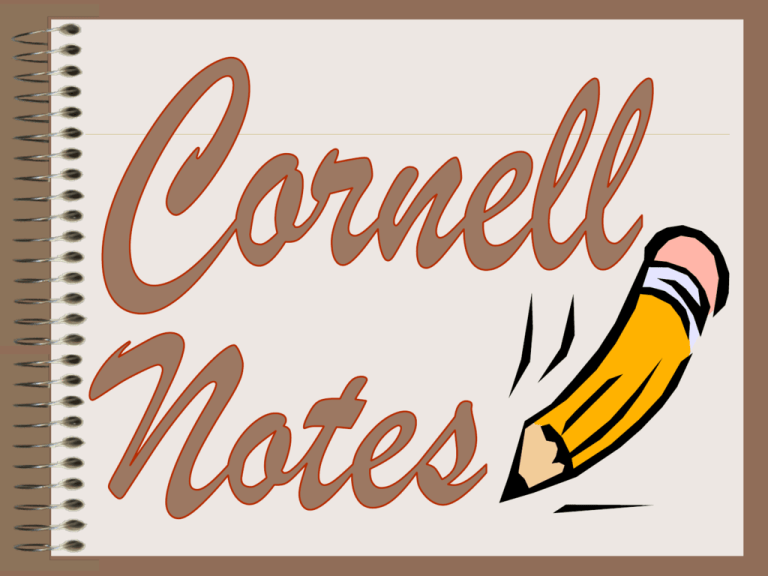
Do Now Questions: • What is the purpose of note-taking? • How did you learn the skill of note taking? • Cornell note taking stimulates critical thinking skills. • Note taking helps students remember what is said in class. • A good set of notes can help students work on assignments and prepare for tests outside of the classroom. • Good notes allow students to help each other problem solve. • Good Notes help students organize and process data and information. • Helps student recall by getting them to process their notes 3 times. • Writing is a great tool for learning! • Developed in 1949 at Cornell University by Walter Pauk. • Designed in response to frustration over student test scores. • Meant to be easily used as a test study guide. • Adopted by most major law schools as the preferred note taking method. Topic Questions, Subtitles, Headings, Etc. First & Last Name Class Title Period Date Class Notes 2 1/2” 3 to 4 sentence summary across the bottom of the last page of the day’s notes Subject: Why take Cornell notes? PROCESS Date: 11/20/01 Main Ideas (input) (output) Can be used to provide an outline of chapter or lecture. Organized by main ideas and details. How can Cornell notes Can be as detailed as necessary. Sequential-- take notes as they are given by instructor or help me text in an orderly fashion. organize my After class, write a summary of what you learned to ideas? clarify and reinforce learning and to assist retention. Can be used as study tool: Which side for 1. Define terms or explain concepts listed on left side. diagrams? 2. Identify the concept or term on the right side. Can be used to provide a "big picture" of the chapter or Why use concept maps? lecture. Organized by main ideas and sub-topics Limited in how much detail you can represent. Simultaneous- you can use this method for instructors who jump around from topic to topic. After class, you can add questions to the left side What are the Can be used as a study tool -- to get a quick overview benefits to me? and to determine whether you need more information or need to concentrate your study on specific topics. Subject: Notetaking Date: 11/20/01 Summary: There are a couple of ways that you can take notes. The Cornell method is best when the information is given in a sequential, orderly fashion and allows for more detail. The semantic web/concept map method works best for instructors who skip around from topic to topic, and provides a "big picture" when you're previewing materials or getting ready to study for a test. • Summary is added at the end of ALL note pages on the subject (not page) • Summary added AFTER questions are finished • Summary should answer the problem stated in the subject. • Let’s get out a sheet of Cornell note paper and get ready to practice the skill. “Overview of Wetlands” • In the large, right hand column, take notes like you normally would. • You may use any style of notetaking you wish: – – – – outline format, narrative format, symbols, short hand, etc. • Compare notes with a partner. • Talk about what you wrote and why. Look for gaps & missed info. • Both partners should feel free to add to their notes. • With your partner(s), create questions in the left hand column. • These questions should elicit critical thinking skills. • On your own, in the space provided at the bottom of the page, complete a 3 or 4 sentence summary of what you wrote in your notes. • (the summary…) Don’t forget the heading: Questions, Name, Class, Period, Date, Topic subtitles, etc. go here, in the left hand column. Remember, we want higher level critical thinking questions. A 3 to 4 sentence summary down there on the bottom of the last page of notes Notes go here, in the large right hand column. 5 Proper set-up and heading Notes are selectively and accurately paraphrased Use of logical abbreviations Notes have been edited, highlighted, and underlined Questions check for understanding and reflect higher levels of inquiry Summary shows learning by effectively summarizing and reflecting on Information and/or asking questions to clarify or further the thinking 4 Proper set-up and heading Notes are selectively and accurately paraphrased Use of logical abbreviations Questions check for understanding and reflect higher levels of inquiry Has a summary 3 Proper set-up and heading Notes may/may not be accurate; information not always paraphrased Some use of abbreviations Questions check for understanding May/may not have a summary 2 Proper set-up Has some notes Has questions May/may not have summary 1 Proper set-up Has notes Questions on left non-existent No summary 0 Improper set-up; not Cornell notes

